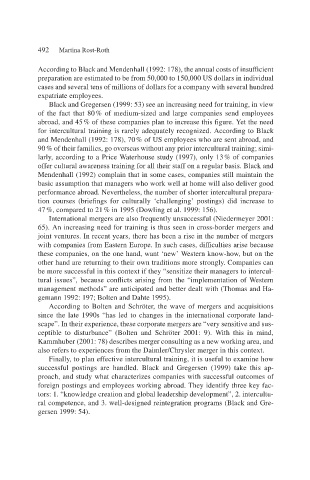Page 514 - Handbooks of Applied Linguistics Communication Competence Language and Communication Problems Practical Solutions
P. 514
492 Martina Rost-Roth
According to Black and Mendenhall (1992: 178), the annual costs of insufficient
preparation are estimated to be from 50,000 to 150,000 US dollars in individual
cases and several tens of millions of dollars for a company with several hundred
expatriate employees.
Black and Gregersen (1999: 53) see an increasing need for training, in view
of the fact that 80% of medium-sized and large companies send employees
abroad, and 45% of these companies plan to increase this figure. Yet the need
for intercultural training is rarely adequately recognized. According to Black
and Mendenhall (1992: 178), 70% of US employees who are sent abroad, and
90% of their families, go overseas without any prior intercultural training; simi-
larly, according to a Price Waterhouse study (1997), only 13% of companies
offer cultural awareness training for all their staff on a regular basis. Black and
Mendenhall (1992) complain that in some cases, companies still maintain the
basic assumption that managers who work well at home will also deliver good
performance abroad. Nevertheless, the number of shorter intercultural prepara-
tion courses (briefings for culturally ‘challenging’ postings) did increase to
47%, compared to 21% in 1995 (Dowling et al. 1999: 156).
International mergers are also frequently unsuccessful (Niedermeyer 2001:
65). An increasing need for training is thus seen in cross-border mergers and
joint ventures. In recent years, there has been a rise in the number of mergers
with companies from Eastern Europe. In such cases, difficulties arise because
these companies, on the one hand, want ‘new’ Western know-how, but on the
other hand are returning to their own traditions more strongly. Companies can
be more successful in this context if they “sensitize their managers to intercul-
tural issues”, because conflicts arising from the “implementation of Western
management methods” are anticipated and better dealt with (Thomas and Ha-
gemann 1992: 197; Bolten and Dahte 1995).
According to Bolten and Schröter, the wave of mergers and acquisitions
since the late 1990s “has led to changes in the international corporate land-
scape”. In their experience, these corporate mergers are “very sensitive and sus-
ceptible to disturbance” (Bolten and Schröter 2001: 9). With this in mind,
Kammhuber (2001: 78) describes merger consulting as a new working area, and
also refers to experiences from the Daimler/Chrysler merger in this context.
Finally, to plan effective intercultural training, it is useful to examine how
successful postings are handled. Black and Gregersen (1999) take this ap-
proach, and study what characterizes companies with successful outcomes of
foreign postings and employees working abroad. They identify three key fac-
tors: 1. “knowledge creation and global leadership development”, 2. intercultu-
ral competence, and 3. well-designed reintegration programs (Black and Gre-
gersen 1999: 54).

